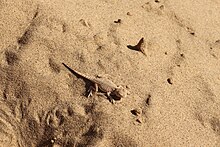Bearded toad head
| Bearded toad head | ||||||||||||
|---|---|---|---|---|---|---|---|---|---|---|---|---|

Bearded toad head ( Phrynocephalus mystaceus ) |
||||||||||||
| Systematics | ||||||||||||
|
||||||||||||
| Scientific name | ||||||||||||
| Phrynocephalus mystaceus | ||||||||||||
| ( Pallas , 1776) |
The bearded toads head ( Phrynocephalus mystaceus ) is a lizard from the family of Agamas and class of phrynocephalus and lives in Central Asia.
features
With a total length of up to 24 cm, the bearded toad head is the largest species in the genus. The head-trunk length is up to 12 cm. It differs from other species by large whisker-like skin folds in the corners of the mouth, which have a series of strongly elongated conical scales on the lower edge. These can be folded up and give the animal a distinctive look. The head is broad, with a blunt-edged tip of the snout. The nostrils are directed forward and up. The tail is flattened along its entire length, its scales are arranged in rings and keeled. The females are slightly smaller than the males, have shorter tails and legs, narrower heads and smaller folds of skin in the corners of the mouth. The species is very variable in drawing and color. The top of the body of adult males is flesh pink, especially on the flanks. The underside of the tail and the breast spot are darker and more intensely colored than in the female. The latter are yellowish in color above and below. Both sexes have irregular, dark, washed-out spots on the upper side, which are sometimes arranged in four to six pairs on the back. The throat has a dark marbling. There is a large black spot on the chest, which is not yet or only weakly developed in young animals. The underside of the body is white, with a light yellow color on the underside of the tail and hind legs, especially in young animals. The tail end is jet black.
distribution
On European soil, the bearded toad head is only found in southern Russia , on the northwestern shore of the Caspian Sea . Here he lives isolated on the Sarykum sickle dune near Kumtorkala in central Dagestan and from the northeastern Caucasus foothills in the east of Chechnya and Kalmykia to the Caspian Depression between the lower reaches of the Volga and Urals rivers in the north. From there the species is distributed over the south of Kazakhstan , Uzbekistan and Turkmenistan to the north of Iran and to the east to the north of Afghanistan and northwest China .
habitat
The bearded toad head is a lowland dweller who is strictly bound to sandy areas and occurs mainly on sickle dunes and in other loosely sandy habitats with sparse shrub and herb vegetation. Self-dug caves serve as hiding places and winter quarters. Especially when there is danger or to protect themselves from the sun, the animals often dig themselves into the loose sand by making quick sideways movements (“shaking in”).
Way of life
At the end of September the old animals go into hibernation, one to two weeks later the young ones. The winter quarters are left in March or April, about three weeks later the mating season begins, which lasts until the beginning of July. The species is extremely territorial. Opposite rivals, the tail is rolled in and out and the body is raised by stretching the legs. Another characteristic feature is the wide opening of the mouth and the folding of the skin flaps in the corners of the mouth. Often there are damage battles. The eggs are laid from the second half of May to the end of July. Usually two clutches of 1–3 eggs 18–20 mm long and 8–10 mm wide are deposited per female, buried 15–20 cm deep in the sand. In the European part of the distribution area, the young hatch from the second half of August.
The diet consists mainly of insects, especially beetles, grasshoppers, cockroaches and ants. Occasionally even small lizards are eaten. Plant food in the form of seeds, leaves and flowers plays only a minor role. The animals are lurker hunters who look for prey buried in the sand up to their nostrils and eyelids, which is then hunted and grabbed in a quick sprint. Adult animals can successfully defend themselves against snakes.
Danger
The IUCN lists the species as not endangered ( least concern ) with a stable population. In the European part of the area, however, the species is partially endangered by intensification of agriculture and changes in the landscape in the sand and dune areas.
Subspecies
- Phrynocephalus mystaceus khorasanus Solovyeva , Dunayev , Nazarov , Radjabizadeh & Poyarkov , 2018
- Phrynocephalus mystaceus mystaceus ( Pallas , 1776)
Can no longer be considered valid:
- Phrynocephalus mystaceus aurantiacaudatus Semenov & Shenbrot , 1990
- Phrynocephalus mystaceus galli Krassowsky , 1932
Individual evidence
- ↑ Phrynocephalus mystaceus in the IUCN Red List of Threatened Species .
- ↑ Dieter Glandt: The amphibians and reptiles of Europe: All kinds in portrait. 2nd, updated and expanded edition. Quelle & Meyer, Wiebelsheim 2015, ISBN 978-3-494-01581-1 .
literature
- Dieter Glandt: The amphibians and reptiles of Europe: All kinds in portrait. 2nd, updated and expanded edition. Quelle & Meyer, Wiebelsheim 2015, ISBN 978-3-494-01581-1 , pp. 479-481.
Web links
- Phrynocephalus mystaceus in The Reptile Database . Edited by: P. Uetz, P. Freed & J. Hošek, 1995–2020. Retrieved August 25, 2020.


